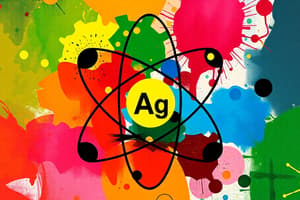Podcast
Questions and Answers
Explain the basic structure of the periodic table and how the elements are arranged within it.
Explain the basic structure of the periodic table and how the elements are arranged within it.
The periodic table arranges elements by increasing atomic number and similar properties. It is divided into rows (periods) and columns (groups). Each element on the table has an atomic number, symbol, name, and average atomic mass. Elements in the same family have similar properties and the same number of valence electrons.
Define atomic number and average atomic mass, and explain their significance in the context of the periodic table.
Define atomic number and average atomic mass, and explain their significance in the context of the periodic table.
Atomic number is the number of protons found in the nucleus of an atom, while average atomic mass is the mass of an atom including protons, neutrons, and electrons. They are important in determining the unique identity and properties of each element.
Describe the properties of elements within a family and provide an example of a family of elements.
Describe the properties of elements within a family and provide an example of a family of elements.
Elements within a family have similar but not identical properties, and they share the same number of valence electrons. For example, lithium (Li), sodium (Na), potassium (K), and other members of family IA are all soft, white, shiny metals.
Explain the significance of periods in the periodic table and describe the properties of elements within a period.
Explain the significance of periods in the periodic table and describe the properties of elements within a period.
What is the relationship between atomic mass and the number of protons and neutrons in an atom?
What is the relationship between atomic mass and the number of protons and neutrons in an atom?
How is the average atomic mass of an atom derived?
How is the average atomic mass of an atom derived?
What determines the placement of elements in a period on the periodic table?
What determines the placement of elements in a period on the periodic table?
Why do elements within a family have similar but not identical properties?
Why do elements within a family have similar but not identical properties?
What is the significance of the atomic number for an element?
What is the significance of the atomic number for an element?
What is meant by saying 'Elements are substances that cannot be broken down any further by chemical means'?
What is meant by saying 'Elements are substances that cannot be broken down any further by chemical means'?
Flashcards are hidden until you start studying




